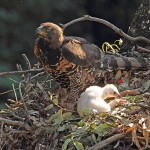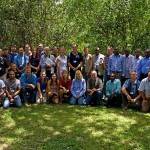Crowned Eagle Research in South Africa – Shane McPherson
The Crowned Eagle research project has taken its first flight. So now one month in, here is an introduction to the research. I have been settling in happily to the University of KwaZulu-Natal in Pietermaritzburg. My supervisors; Prof Colleen Downs, and Dr. Mark Brown have been great people to get to know. It is exciting to be part of a larger gathering of urban ecology studies, three of us focusing on predators. Craig Widdows is starting an MSc on Spotted Genets, and Erin Wreford is well underway with MSc research on Black Sparrowhawks. The success of the Sparrowhawks as they become urban exploiters is demonstrated by the impressive 53 nests that make up Erins population.
The work on these eagles in the suburban areas puts a challenging aspect to my project. Unlike research in ‘ the wilds’, there is a prominent necessity for me to relate to many and various residents in the neighborhoods. Thankfully, I can say that I have met only remarkably welcoming and supportive people.
The members of the Natal Falconry Club have been so helpful, and particularly the chairman Bruce Padbury, who has undoubtedly started me off with a solid foundation of local raptor knowledge, social networking, and all-round fervor. The first day of reconnaissance in the city I was shown seven nest sites!
Over the last couple of days I built a BelChatri trap from scratch, getting wire mesh from the Animal House on campus, and the remaining materials from the local hardware and fishing shops. I finished the trap late last night, then set off with the mission early thismorning. Having to sit out the rain and hail was a worrying start to the morning, but our early start was rewarded with the plaintive calls of the hungry eagle echoing up the valley. We eventually pinpointed the bird, and were invited into a property only 30 meters from last summers nest, with the young bird sitting above us in a gum tree on the corner of the back yard.
In the presence of a Crowned eagle, both young and adults, I am in complete awe. The kiwi/maori term that I can’t quite rival in any other language is mana. It is a privilege to find myself here doing this research.
After a heart-stopping half hour of watching this eagle, not 20 meters away, being reticent around the trap and perching a few meters above it, and cautiously checking all around for the presence of dogs, and people. Sitting at a table on the porch, Mark and I were side by side, me with binoculars and Mark with camera in hand. We sat in full view of her – completely hyped on adrenaline but simultaneously having to suppress even the slightest movement or twitch. Eventually, satisfied that the people were no threat and there were no large dogs around, the inquisitive side took over, and the eagle descended to the trap and was caught. While handling the bird, one is mindful of the enormous foot mass, the powerful muscles in the legs, the grip, and those talons! The hind talon was itself just shy of 60mm, and all the while the voice of Simon Thomsett echoes in my head “the Crowned Eagle has the largest killing implement of any predator in Africa”, the largest females may have a hind talon 100mm long. I can’t give enough thanks to Mark and Bruce for the cool heads and steady hands (well, at least metaphorically) while we ringed, then measured this bird.
There are thoughts, hopes, and admittedly, some doubt. Was this an unusually fortunate success, and will the others be extremely challenging, or is it the average behavior to expect from these juveniles. No doubt the adults with years of experiences behind them will be extremely cautious. And as capturing adults is a priority objective of the project, attaching GPS transmitters in order to examine their home range, then it will be largely irrelevant as to how easily the juveniles are caught.
The main goals of the project will be to investigate the urban and peri-urban distribution, and ecological aspects of nest site selection, diet, home range, and habitat use. We are ambitiously hoping to find all the nests and pairs within the D’MOSS (Durban Metropolitan Open Space System), reserves and private lands within the greater urban areas of Durban and Pietermaritzburg. The diet of the eagles will be studied with the aid of motion activated cameras looking into the nest. While the home range and habitat use of breeding pairs will, as mentioned, be obtained from extraordinary developments in GPS technology: miniature 37 gram units with weekly GSM data transmission.
For the meantime the project is developing nicely, though there is opportunity here for you to support the project. Particularly there is need for financial sponsorship of camera and telemetry equipment, a stipend, and small donations. In any case please subscribe to the blog, at the bottom of the page.
For now at least, there is one juvenile out there with a ring – and we hope that this will become many over the course of the next few years. It is fantastic to think that in five, ten, even twenty years time, these ringed birds may be re-sighted in the urban population – providing us with much needed information about dispersal, recruitment, and lifespan. That is – ultimately – the value of today’s exercise.
The author would like to acknowledge Mark Brown and Mark Wynn for their photos.
This article was reproduced by kind permission from the website http://kzn-ce.blogspot.com/2012/05/crowned-eagles-may-update.html







Sunday 29th July 2012
Shane I believe ringed his third juvenile eagle today, nickname “Bert”, here in Winterskloof. What a special privilege to have witnessed this procedure – one I shall never forget. Thank you.
Eileen Rasmussen.
Hi Shane – Please give me call on 083 212 0560. I would love to share information with you. For 9 months I have been observing and photographing a resident pair of Crowned Eagles on the San Lameer Golf Estate 140 kms south of Durban. The site to some extent qualifies for “urban” because it features a large number of homes and a constant flow of people, vehicles, pedestrians, lawn mowers and urban noise, none of which seems to bother the eagles.
Recently I was able to photograph the mating game of the adults and have built up a blow-by blow of the new nest building process as well as the development of the juvenile over the 9 months. All three these eagles are very easily accessible to researchers.
A juvenile of identical age and apperance was killed four weeks ago after settling on high-voltage powerlines only 8 kms from San Lameer.
Regards, Jacques Sellschop
I have been keeping my eye on a Crowned Eagle nest in Krantzkloof. 2-3 years ago they had a chick. And there is currently one that is learning to fly. I have noticed that the one from the previous season was a lot darker in colour than the one of this season. As I can’t be there every week, I am not sure if this could mean the lighter one is male or is it just an age difference that could cuase this. I LOVE watching these birds and every year I go there to see if I don’t just maybe see the nest active again!
Is this blog still active? What has become of the research?
Hi. I got some stunning photographs of a juvenile crowned eagle at Zimbali yesterday. It has tags on its legs and one eye has a strange marking. Not sure if you are keen to see these, but I was wondering if the one tag….the narrow metal one …. is not too tight…. or maybe it is just the feathers that make it look like that. Benine du Toit
We are on holiday in Southbroom, KZN south coast and yesterday a juvenile (?)Crowned Eagle landed so gracefully in our milk wood tree. I have some quite nice pics that you would be welcome to use. My cell is 0826782924. Rose Bishop